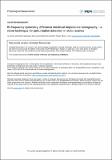| dc.contributor.author | McDermott, Barry | |
| dc.contributor.author | Avery, James | |
| dc.contributor.author | O'Halloran, Martin | |
| dc.contributor.author | Aristovich, Kirill Y. | |
| dc.contributor.author | Porter, Emily | |
| dc.date.accessioned | 2019-02-25T12:51:56Z | |
| dc.date.issued | 2019-02-20 | |
| dc.identifier.citation | Barry James, McDermott, James, Avery, Martin, O'Halloran, Kirill, Y. Aristovich, & Emily, Porter. (2019). Physiological Measurement.,doi:10.1088/1361-6579/ab08ba | en_IE |
| dc.identifier.issn | 1361-6579 | |
| dc.identifier.uri | http://hdl.handle.net/10379/14995 | |
| dc.description.abstract | Objective: A novel method for the imaging of static scenes using Electrical Impedance Tomography (EIT) is reported with implementation and validation using numerical and phantom models. The technique is applicable to regions featuring symmetry in the normal case, asymmetry in the presence of a perturbation, and where there is a known, frequency-dependent change in the electrical conductivity of the materials in the region. Methods: The stroke diagnostic problem is used as a motivating sample application. The head is largely symmetrical across the sagittal plane. A haemorrhagic or ischaemic lesion located away from the sagittal plane will alter this natural symmetry, resulting in a symmetrical imbalance that can be detected using EIT. Specifically, application of EIT stimulation and measurement protocols at two distinct frequencies detects deviations in symmetry if an asymmetrically positioned lesion is present, with subsequent identification and localisation of the perturbation based on known frequency-dependent conductivity changes. Anatomically accurate computational models are used to demonstrate the feasibility of the proposed technique using different types, sizes, and locations of lesions with frequency-dependent (or independent) conductivity. Further, a realistic experimental head phantom is used to validate the technique using frequency-dependent perturbations emulating the key numerical simulations. Results: Lesion presence, type, and location are detectable using this novel technique. Results are presented in the form of images and corresponding robust quantitative metrics. Better detection is achieved for larger lesions, those further from the sagittal plane, and when measurements have a higher signal-to-noise ratio. Conclusion: Bi-Frequency Symmetry Difference EIT is an exciting new modality of EIT with the ability to detect deviations in the symmetry of a region that occur due to the presence of a lesion. Notably, this modality does not require a time change in the region and thus may be used in static scenarios such as stroke detection. | en_IE |
| dc.description.sponsorship | The research leading to these results has received funding from the European Research Council under the
European Union’s Horizon 2020 Programme/ ERC Grant Agreement BioElecPro n.637780, Science Foundation
Ireland (SFI) grant number 15/ERCS/3276, the Hardiman Research Scholarship from NUIG, the charity
RESPECT and the People Programme (Marie Curie Actions) of the European Union’s Seventh Framework
Programme (FP7/2007-2013) under REA Grant Agreement no. PCOFUND-GA-2013-608728. James Avery was
supported by the NIHR Imperial BRC. | en_IE |
| dc.format | application/pdf | en_IE |
| dc.language.iso | en | en_IE |
| dc.publisher | IOP Publishing | en_IE |
| dc.relation.ispartof | Physiological Measurement | en |
| dc.rights | Attribution-NonCommercial-NoDerivs 3.0 Ireland | |
| dc.rights.uri | https://creativecommons.org/licenses/by-nc-nd/3.0/ie/ | |
| dc.subject | Biomedical Imaging | en_IE |
| dc.subject | Electrical Impedance Tomography | en_IE |
| dc.subject | Reconstruction Algorithm | en_IE |
| dc.title | Bi-frequency symmetry difference electrical impedance tomography a novel technique for perturbation detection in static scenes | en_IE |
| dc.type | Article | en_IE |
| dc.date.updated | 2019-02-21T09:57:40Z | |
| dc.identifier.doi | 10.1088/1361-6579/ab08ba | |
| dc.local.publishedsource | https://dx.doi.org/10.1088/1361-6579/ab08ba | en_IE |
| dc.description.peer-reviewed | peer-reviewed | |
| dc.contributor.funder | Horizon 2020 | en_IE |
| dc.contributor.funder | European Research Council | en_IE |
| dc.contributor.funder | Science Foundation Ireland | en_IE |
| dc.contributor.funder | Hardiman Research Scholarship, NUI Galway | en_IE |
| dc.contributor.funder | Seventh Framework Programme | en_IE |
| dc.description.embargo | 2020-02-20 | |
| dc.internal.rssid | 15903495 | |
| dc.local.contact | Barry Mc Dermott, Translational Medical Device Lab, , 2nd Floor Lambe Translational Research Facility,, University College Hospital, , Galway. - Email: b.mcdermott3@nuigalway.ie | |
| dc.local.copyrightchecked | Yes | |
| dc.local.version | ACCEPTED | |
| dcterms.project | info:eu-repo/grantAgreement/EC/H2020::ERC::ERC-STG/637780/EU/Frontier Research on the Dielectric Properties of Biological Tissue/BIOELECPRO | en_IE |
| dcterms.project | info:eu-repo/grantAgreement/SFI/SFI ERC Support Programme/15/ERCS/3276/IE/BIOELECPRO: Frontier Research on the Dielectric Properties of Biological Tissue/ | en_IE |
| dcterms.project | info:eu-repo/grantAgreement/EC/FP7::SP3::PEOPLE/608728/EU/Assistive Technologies in Autism and Intellectual Disability/ASSISTID | en_IE |
| nui.item.downloads | 189 | |


